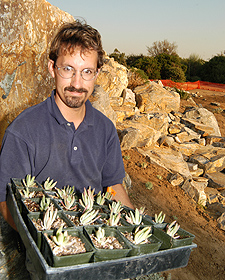You won’t find any Van Goghs or Monets in the
collections at the Fullerton Arboretum; rather, what visitors to
the 26-acre botanical garden encounter are the living “muses”
that inspire artists and delight the senses. Keeping track of this
assemblage of flora is Chris Barnhill, curator of plant collections.
| Q: |
What do your responsibilities consist
of? |
| A: |
Part of my responsibilities are caring for and
keeping records of all of the plants on the arboretum grounds.
Much like a museum curator, except in this case, the items are
living and growing — sometimes they die, sometimes they
can be a little aggressive or a bit finicky, but ultimately,
very interesting. |
|
| Q: |
Were you given any particular charge
or assignment when you came on board in 1999? |
| A: |
It was to acquire plants and develop the existing
collections. I’m always looking for new and interesting
plants and seeds to increase the quality of our collections
— having them more botanically diverse. We want to increase
the diversity of our collections so we have more to inform,
enlighten and delight the public, and to be an educational —
and beautiful - resource for the general public and university. |
|
| Q: |
What about your own goals for the arboretum?
|
| A: |
Developing the arboretum is a collaborative
effort, but I do have a particular fondness for plants from
regions with a climate similar to our own, a Mediterranean climate.
Two of these regions I find particularly exciting are South
Africa and our local Southern California flora. Displays of
plants from both these regions can be found at the arboretum.
|
|
| Q: |
What has been going on with the Channel
Islands garden? |
| A: |
We rebuilt the new and improved Channel Islands
garden after we completed our new nursery complex. |
|
| Q: |
Are there many differences between the
old and new sites? |
| A: |
It’s larger and we were able to enhance
it and diversify the collection. We were able to obtain a
lot of soil from the excavation at the Performing Arts Center
so we could build a larger berm and do some plantings on it
to visually block out the nursery site and the 57 freeway.
A supporter of the arboretum, Doug Myles, has quite an interest
in the Channel Islands and was willing to help fund and support
the rebuilding of this garden. Doug and I spent time thinking
about how we wanted to recreate this garden. We wanted to
show plants from the different ecological communities. On
the berm, you’ll see many beautiful plants, some of
them endemic to the Channel Islands, growing in the coastal
bluff community. Other plant communities in this garden are
an island grassland, woodland and chaparral. There is also
a coastal strand or southern beach and dune community complete
with native plants growing in the sand. I’m waiting
to find a sunbather enjoying a cool margarita amongst the
sand-spurry and San Miguel locoweed! |
|
| Q: |
When do you think the garden will be
“finished,” so to speak? |
| A: |
Gardens are always changing and evolving, but
the majority of plants for this garden are in the ground and
growing quickly. This spring, the garden will be beautiful with
all the grasses and wildflowers in bloom. I recommend taking
a walk though the Channel Islands garden — or better yet,
the whole arboretum — every month to observe the different
plants flowering, setting seed or showing off something exciting. |
|
| Q: |
Will you have a hand in any of the landscaping
for the new visitors center? |
| A: |
Yes, and it will require planting many plants
in the ground. Since there may be a few people reading this
interview, I’d like to extend an invitation to volunteer
at the arboretum. I can think of at least one project I will
need enthusiastic plant lovers to help with! |
|
| Q: |
You’re also a published photographer
and author. What projects have you been involved in? |
| A: |
I was the photographer for two tomes on
the genera lithops and conophytum from South Africa. The first
book is titled “Lithops, Treasures of the Veld,”
the second, “Dumpling and His Wife, New Views on the
Genus Conophytum.”
I’ve had photos published in various journals and was
a contributor to a couple other books on South African plants,
including “Mesembs of the World.”
I was co-author on the publication of a couple new species
of conophytum found in South Africa in 1996. |
|
| Q: |
Do you conduct any of the arboretum
classes? |
| A: |
Yes, I’ve taught classes to children and
adults on propagation, California natives, butterfly gardening
and plants from South Africa. |
|
| Q: |
With the capacity to host larger groups
in the new visitors center, how will you be involved? |
| A: |
I will probably teach some classes and help
find other experts in their fields to give lectures and talks.
There will be lots going on, so stay tuned and keep visiting
the arboretum. |
